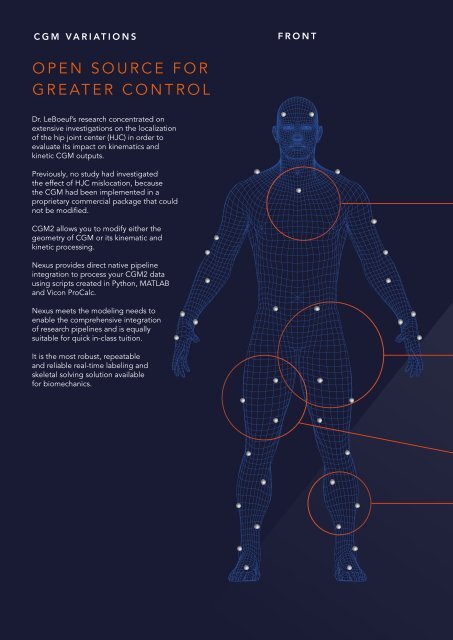NEXUS Brochure
Create successful ePaper yourself
Turn your PDF publications into a flip-book with our unique Google optimized e-Paper software.
CGM VARIATIONS<br />
FRONT<br />
OPEN SOURCE FOR<br />
GREATER CONTROL<br />
Dr. LeBoeuf’s research concentrated on<br />
extensive investigations on the localization<br />
of the hip joint center (HJC) in order to<br />
evaluate its impact on kinematics and<br />
kinetic CGM outputs.<br />
CGM2.5<br />
UPPER BODY MODEL<br />
Marker sets for upper thorax model.<br />
Previously, no study had investigated<br />
the effect of HJC mislocation, because<br />
the CGM had been implemented in a<br />
proprietary commercial package that could<br />
not be modified.<br />
CGM2 allows you to modify either the<br />
geometry of CGM or its kinematic and<br />
kinetic processing.<br />
Nexus provides direct native pipeline<br />
integration to process your CGM2 data<br />
using scripts created in Python, MATLAB<br />
and Vicon ProCalc.<br />
Nexus meets the modeling needs to<br />
enable the comprehensive integration<br />
of research pipelines and is equally<br />
suitable for quick in-class tuition.<br />
CGM2.1<br />
HIP JOINT CENTER<br />
ACCURACY<br />
Uses the regression equations of Hara et al.<br />
(2016) to estimate the position of the hip<br />
joint center based on a measurement of leg<br />
length taken from the measured position of<br />
markers during the static calibration trial.<br />
It is the most robust, repeatable<br />
and reliable real-time labeling and<br />
skeletal solving solution available<br />
for biomechanics.<br />
CGM2.3<br />
SKIN CLUSTERS<br />
Removes thigh and tibia wand markers<br />
and replaces these with a small number of<br />
tracking markers (skin clusters) placed over<br />
the femur and shank segments.


